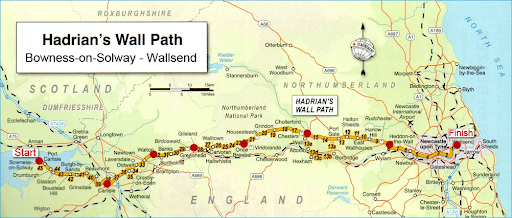Multiculturality in Ancient Britannia at Hadrian's Wall
- rawi12
- Feb 23, 2021
- 2 min read
Updated: Apr 12, 2021
For people who love to travel the pandemic is creating significant difficulties for coming in contact with people and places where one can explore different world cultures. Hadrian’s Wall offers an opportunity to explore a range of different cultures from all over the ancient world, which greatly impacted modern Britain. Construction of the wall is believed to have begun early in the reign of Emperor Hadrian and is thought to have taken at least 6 years to complete . The Wall spans 80 Roman miles, or 73 modern miles, running the width of Britain from Wallsend on the River Tyne in the east to Bowness-on-Solway in the west. According to the Historae Augustae Hadrian built the wall to separate the barbarians from the Romans although there is debate surrounding the walls defensive capability. Many scholars believe that rather than being intended to indefinitely repel invaders like a medieval siege defense, the wall was meant to survey the frontier and slow attacks for reinforcements to arrive. The wall was built with alternating forts placed about every seven miles. These forts would have contained about 600 men. The wall also featured smaller milecastles which housed between 12 and 20 soldiers every mile with watchtowers placed even more frequently .
Although roman legions are thought to have constructed the wall, the soldiers who manned the wall were auxiliaries drawn from provinces all across the Roman Empire including places like modern day North Africa, Iraq, Syria, France, Germany, and Greece as is detailed in the Notitia Dignitatum . In addition to bringing in soldiers from around the Empire the wall would have also caused the movement of many soldiers families to live in areas near the wall . This brought different cultures from around the Roman Empire to Britain in many forms including architecture, cooking utensils, footwear, and religion. Although many material artifacts have not survived visitors to the wall can still observe the impact of Roman occupation in the fauna surrounding the trails which is often influenced by the movement of Roman plant species to the fortifications . Hadrian’s Wall is today equipped with an adjacent walking trail which allows visitors to travel along the entire extent of the wall. Hadrian’s wall can be explored in its entirety as it has camping locations designated along the trail which allow hikers to walk from one side of the wall to the other in about 5-6 days depending on the pace preferred. The wall is also easily accessible by road at any points and can be explored in shorter segments as well. More information can be found at https://hadrianswallcountry.co.uk/visit.








Comments